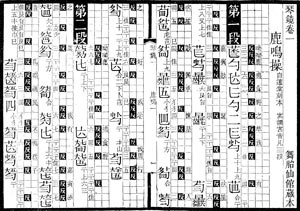Opening (QQJC XXX/3)
This section includes a 總序 General Introduction a 目錄 ToC and a brief 聲律統考詳解 Focused Examination and Detailed Explanation of Musical Sounds that ends with a handwritten note that Yang Shibai died in 1933.
冊一 Book One 琴粹一 Qin Cui (Specially Excellent Qualities of Qin) (1911; XXX/8-53)
Afterwords for Qin Cao (XXX/31)
Most of the tablature for the qin in Qinxue Congshu uses a special system that indicates rhythm, as at right. In this system there are three extra lines going along with the tablature. The first line has either the lyrics or the names of the relative pitch; the second line marks the beat [sometimes this is omitted, presumably where the music is particularly free]; the third line shows specifically what the hand is doing when the lyric or note occurs; the fourth has the actual tablature.)
There are 29 pieces using this tablature in five books, three (books #6, #7 and #8) called Mirror on the Qin, one (9) called Mirror on the Qin Supplement, and one (#13) called Mirror on the Qin Continuation. (Compare the tablature for qin and se together in Book 10.)
琴鏡自序 Preface to Qin Jing (XXX/199)
The Continuation of Qin Jing (Book 12, below), has four more solo qin melodies using this system.
Introductions and ToC for Book 1; further commentary (XXX/8)
Qin Cao of Cai Yong (XXX/17)
With comments on each of the melodies listed.
Rest of Qin Cao of Cai Yong
幽蘭原譜等 (You Lan original tablature, etc.)
古琴考 Guqin Kao (Studies of Guqin
冊二 Book 2 琴話卷 Qin Hua (Speaking of Qin) (1913; XXX/54-104)
Prefaces for Book 2 (XXX/54)
Qin Hua Folio 1 (XXX/56)
冊三 Book 3 琴譜 Qin Pu (Qin Tablature) (1914; XXX/105-136)
Book 3 Prefaces about the ancient You Lan in Jieshi Mode (XXX/105)
幽蘭自序 You Lan prefaces (XXX/108)
幽蘭例言 You Lan Outline (XXX/109)
幽蘭古指法解 You Lan Old Finger Techniques (XXX/111)
幽蘭減字譜 You Lan in Shorthand Tablature (XXX/115)
(Qinxue Congshu Folio 24 below has a version of this in its tablature with rhytmic indication)
幽蘭雙行譜 You Lan in Longhand Tablature paired to Shorthand Tablature (XXX/117)
流水自序」例言 Prefaces
流水(天聞閣七十二滾拂版本)The 72 Gunfu Liu Shui from
Tianwen'ge Qinpu (copied with fingering explanations)
冊四 Book 4 琴學隨筆 Qinxue Suibi (Qin Study Jottings) (1919; XXX/137-166)
Preface (XXX/137)
Qin Study Jottings #1 (XXX/138)
冊五 Book 5 琴餘漫錄 Qin Yu Manlu (Casual Extra Notes about Qin) (1919; XXX/167-198)
冊六 Book 6 琴鏡 Qin Jing (Mirror on the Qin) Part 1 (1918; XXX/199-239)
Tablature in Qin Jing
(expand)
 (with Qin tablature using the system at right to indicate note values)
(with Qin tablature using the system at right to indicate note values)
琴鏡目錄 ToC for Qin Jing (XXX/200)
例言 Introductory Comments for Qin Jing (XXX/201)
指法說明 Fingering explanations for Qin Jing (XXX/202)
冊七六續 Book 6 (cont.) 琴鏡 Qin Jing (Mirror on the Qin) Part 2 (1922; XXX/239-276)
(with qin tablature using the system above to indicate note values)
冊六續 Book 6 (cont.) 琴鏡 Qin Jing (Mirror on the Qin) Part 3 (1923; XXX/276-286)
(with qin tablature using the system above to indicate note values)
冊七 Book 7 琴鏡補 Qin Jing Bu (Supplement to Mirror on the Qin) (1923; XXX/313-347)
(with qin tablature using the system above to indicate note values)
叙、目錄 Prefaces, ToC
指法、上絃法、調絃法 Finger techniques, putting on strings, tuning methods
Paired with Qu Yuan's poem (not following the common pairing method)
Paired with Cai Yan's poem
(not by the common pairing method);
at the end there is comment (附胡笳填詞譜書眉評語)
Standard tuning; gong mode; "avoid open third string"; paired with a variant of Li Bai lyrics (XXX/344)
冊八 Book 8 琴瑟合譜 Qin Se Hepu (Tablature for Qin with Se) (1925; XXX/348-369)
自叙、目錄 Preface, ToC
(using a variant of the
above tablature to indicate note values)
例言 (includes charts such as
hui marker positions for guqin).
冊九 Book 9 琴學問答 Qin Xue Wenda (Qin Study Dialogue) (1923; XXX/370-381)
琴師傳、瑟譜書後、彈琴詩
冊十 Book 10 藏琴錄 Zang Qin Lu Record of Collected Qins) (1925; XXX/382-387)
No images
冊十一 Book 11 琴瑟新譜 Qin Se Xin Pu (New Tablature for Qin and Se) (1929; XXX/388-417)
(using a variant of the
above tablature to indicate note values)
12 short pieces with lyrics and notes but no qin tablature:
9 short pieces with lyrics and notes but no qin tablature
12 short pieces with lyrics and notes but no qin tablature
孔廟釋尊樂章 Confucian Temple Songs with lyrics and notes but no qin tablature
冊十二 Book 12 琴鏡續 Qin Jing Xu (Continuation of Mirror on the Qin
(1931; see Book 6 above; XXX/418-464)
(with more qin tablature using the system above to indicate note values)
Essays
Two pieces from Shen Qi Mi Pu
冊十三 Book 13 (琴鏡釋疑 Qin Jing Shiyi (Resolving Issues about Mirror of the Qin) (1931; XXX 465-502)
冊十四 Book 14 (幽蘭和聲 You Lan Hesheng (The Harmony of You Lan) (1931; XXX 465-502)
冊十五 Book 15 (琴鏡釋疑 Qin Jing Shiyi (Dispelling Doubts about Mirror of the Qin) (1931; XXX 465-502)
